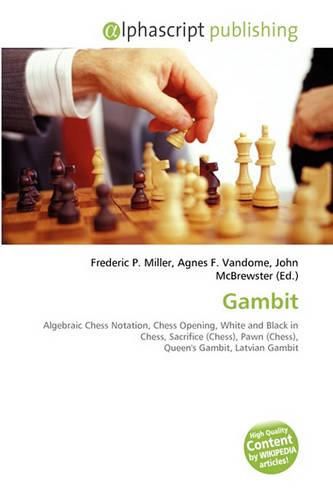Readings Newsletter
Become a Readings Member to make your shopping experience even easier.
Sign in or sign up for free!
You’re not far away from qualifying for FREE standard shipping within Australia
You’ve qualified for FREE standard shipping within Australia
The cart is loading…






High Quality Content by WIKIPEDIA articles! A gambit (from ancient Italian gambetto, meaning tripping) is a chess opening in which a player, most often White, sacrifices material, usually a pawn, with the hope of achieving a resulting advantageous position. Some well-known examples are the King’s Gambit (1.e4 e5 2.f4), Queen’s Gambit (1.d4 d5 2.c4), and Evans Gambit (1.e4 e5 2.Nf3 Nc6 3.Bc4 Bc5 4.b4). A gambit used by Black may also be called a gambit (e.g., Latvian Gambit (1.e4 e5 2.Nf3 f5), Englund Gambit (1.d4 e5), but is sometimes called a countergambit (e.g., Albin Countergambit) (1.d4 d5 2.c4 e5) or Greco Counter-Gambit, an old-fashioned name for the Latvian Gambit). The word gambit was originally applied to chess openings in 1561 by Spanish priest Ruy Lopez de Segura, from an Italian expression dare il gambetto (to put a leg forward in order to trip someone). Lopez studied this maneuver, and so the Italian word gained the Spanish form gambito that led to French gambit, which has influenced the English spelling of the word. The broader sense of opening move meant to gain advantage was first recorded in English in 1855.
$9.00 standard shipping within Australia
FREE standard shipping within Australia for orders over $100.00
Express & International shipping calculated at checkout
High Quality Content by WIKIPEDIA articles! A gambit (from ancient Italian gambetto, meaning tripping) is a chess opening in which a player, most often White, sacrifices material, usually a pawn, with the hope of achieving a resulting advantageous position. Some well-known examples are the King’s Gambit (1.e4 e5 2.f4), Queen’s Gambit (1.d4 d5 2.c4), and Evans Gambit (1.e4 e5 2.Nf3 Nc6 3.Bc4 Bc5 4.b4). A gambit used by Black may also be called a gambit (e.g., Latvian Gambit (1.e4 e5 2.Nf3 f5), Englund Gambit (1.d4 e5), but is sometimes called a countergambit (e.g., Albin Countergambit) (1.d4 d5 2.c4 e5) or Greco Counter-Gambit, an old-fashioned name for the Latvian Gambit). The word gambit was originally applied to chess openings in 1561 by Spanish priest Ruy Lopez de Segura, from an Italian expression dare il gambetto (to put a leg forward in order to trip someone). Lopez studied this maneuver, and so the Italian word gained the Spanish form gambito that led to French gambit, which has influenced the English spelling of the word. The broader sense of opening move meant to gain advantage was first recorded in English in 1855.